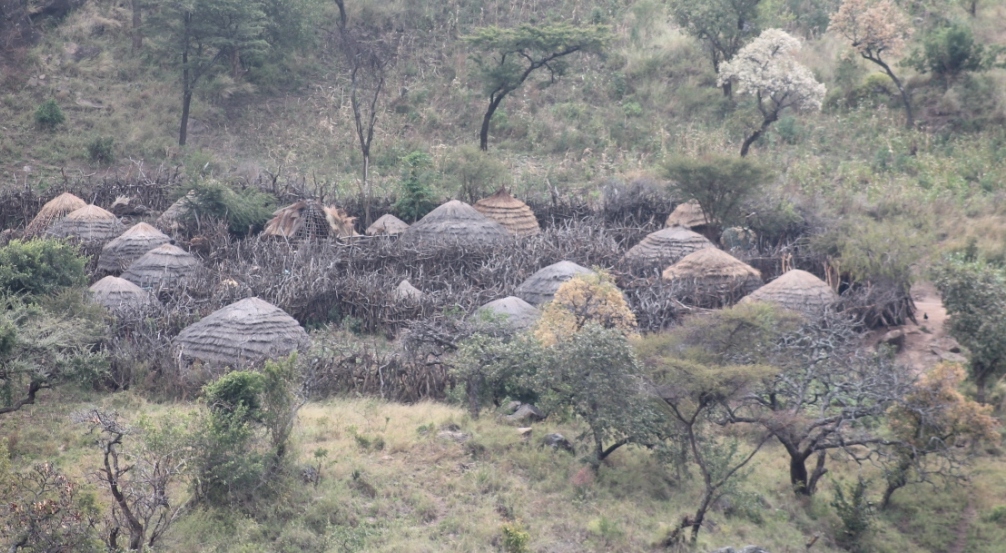Karamojong Manyattas, the homestead of the Karamajong people found in Northeastern Uganda at Kidepo Valley National Park is one of the unique experience that is not found elsewhere in Uganda. The Karamajong Manyattas is cultural setting of home steads among the K’jongs has played a great role in boosting Uganda’s cultural tourism with their unique cultural life style like that of the Masai in Kenya. A Karamojong village is also known as “Manyatta” or “Ere” meaning an enclosed residential area, surrounded by sharp thorns and with small entry points for people and a larger entry point for cattle. One Manyatta has multiple families and a communal space for cattle. Book Now

The Manyattas
The Karimojong (Ŋikarimojong), the largest Karamojong group, live in southern Karamoja and are traditionally subdivided into the Bokora (Ŋibokora; mostly in what is now Napak District), Matheniko (Ŋimaseniko; in Moroto District) and Pian (Ŋipian;in Nakapiripirit District). The Karimojong lands are bordered to the north by Kotido District, inhabited by the Jie (Ŋijie). The final Ugandan group of the Cluster are the Dodoth (Ŋidoso) who live in Kaabong District in the north of Karamoja.
The Karamojong reside in the largely permanent Manyattas during the wet /rainy season. As soon as the weather conditions are suitable for agriculture and livestock herding. Men stay mainly in the Kraal during dry season as they migrate closer to water sources, woman and children remain in the Manyattas to prepare of Agriculture production and others look for income generating activities ‘Elejilej’.
The Karamojong are proud of their traditional lifestyle which even in Uganda is often misunderstood, as being backward and being considered as primitive people. However much negatively people has had bad myth towards the Karamajongs, as they have not been understood. They have played a great role towards keeping their culture intact.
Todays the so one time taken as backward and primitive, is one of the most selling culture in line of cultural tourism that has attracted thousands and thousands of tourist who do pay a visit to the area to see the Karamajong manyattas home stead style of building.
The Karamajongs live and dies for their cattle, to an extent that a Karamajong can leave behind 100 cattle and go and look for one which is missing, they value their cattle so much than anything and you dare come their way it means loss of your life. To the Karamojong People, cattle is royalty and the number of cattle one owns measure the value and recognition of a man.
The cattle kraal is built and surrounded by the manyattas. This only can show how much security is put in safe guarding the cattle’s. Just as young girls build miniature huts, boys of a similar age begin to construct small-scale barriers as practice for their adult roles of building and maintaining the enclosures around the manyattas and kraals. Young boys also hunt small game around both the manyattas and kraals, usually with bows and arrows that they have crafted themselves.
The building of huts (at both kraals and manyattas) is the duty of older girls and women, as is building and maintaining the fences immediately around the homesteads, and building the enclosures for the goats and calves inside the fences. Young men are primarily responsible for the outer fence of the manyatta or kraal, but may receive help from women to collect and carry the branches and thorn bushes. When a kraal moves to a new location, women pack up the households and load the supplies onto donkeys or, more rarely, camels for the journey. The Karamajong manyattas are built using rids, grasses, mad and clay soil is preferred. The manyattas is maintained through smearing the walls and floor of the house with either thin layer of clay soil or cow dung.
Uganda is such a rich country with diverse unique culture, further in southwest in Mgahinga National Park is the famous Batwa people and the Bakonzo people a long the foothills of Mt. Rwenzori National Park. All these community interactions are worth exploring for guests that are in to meeting nd learning about local life.
